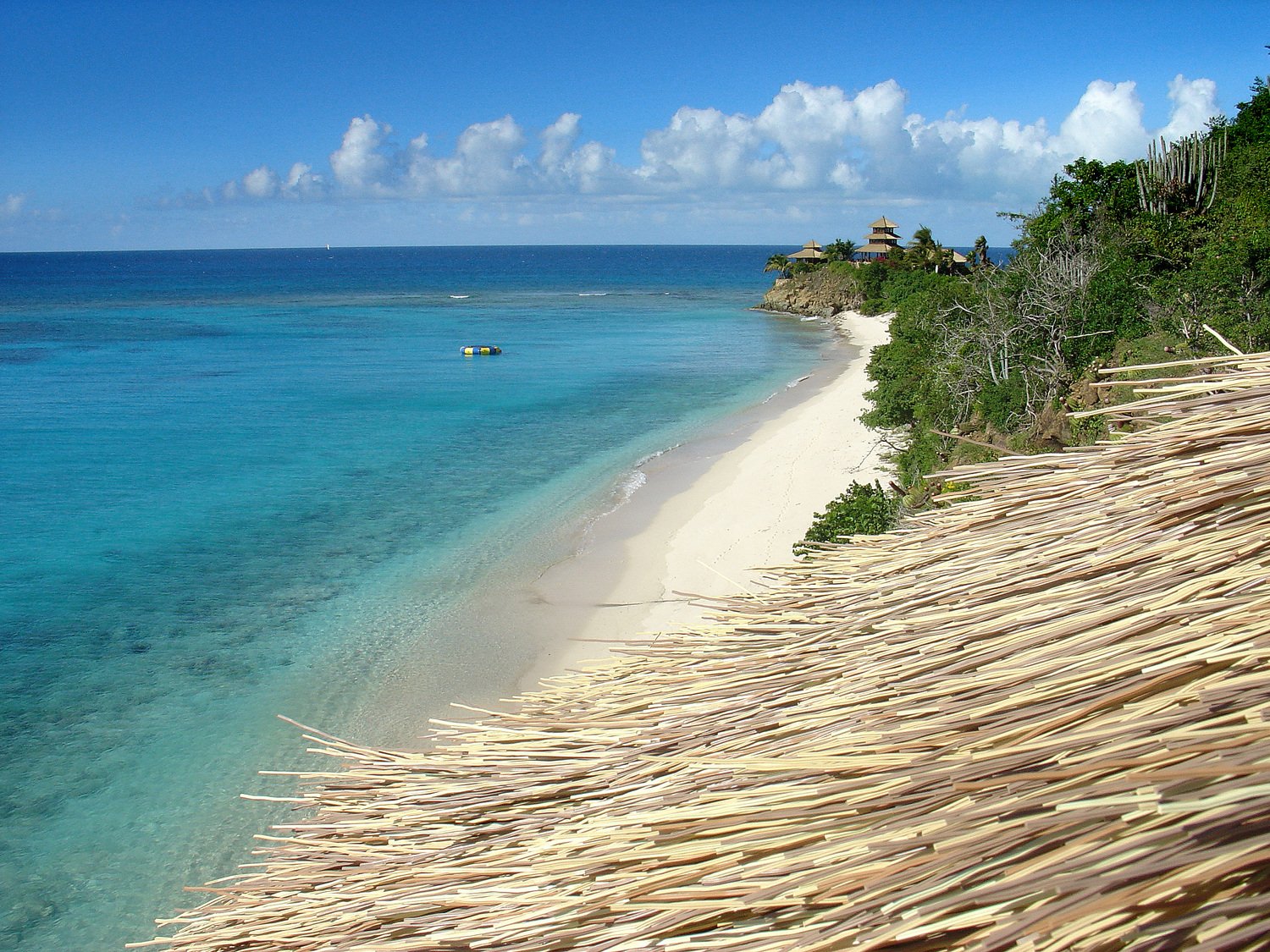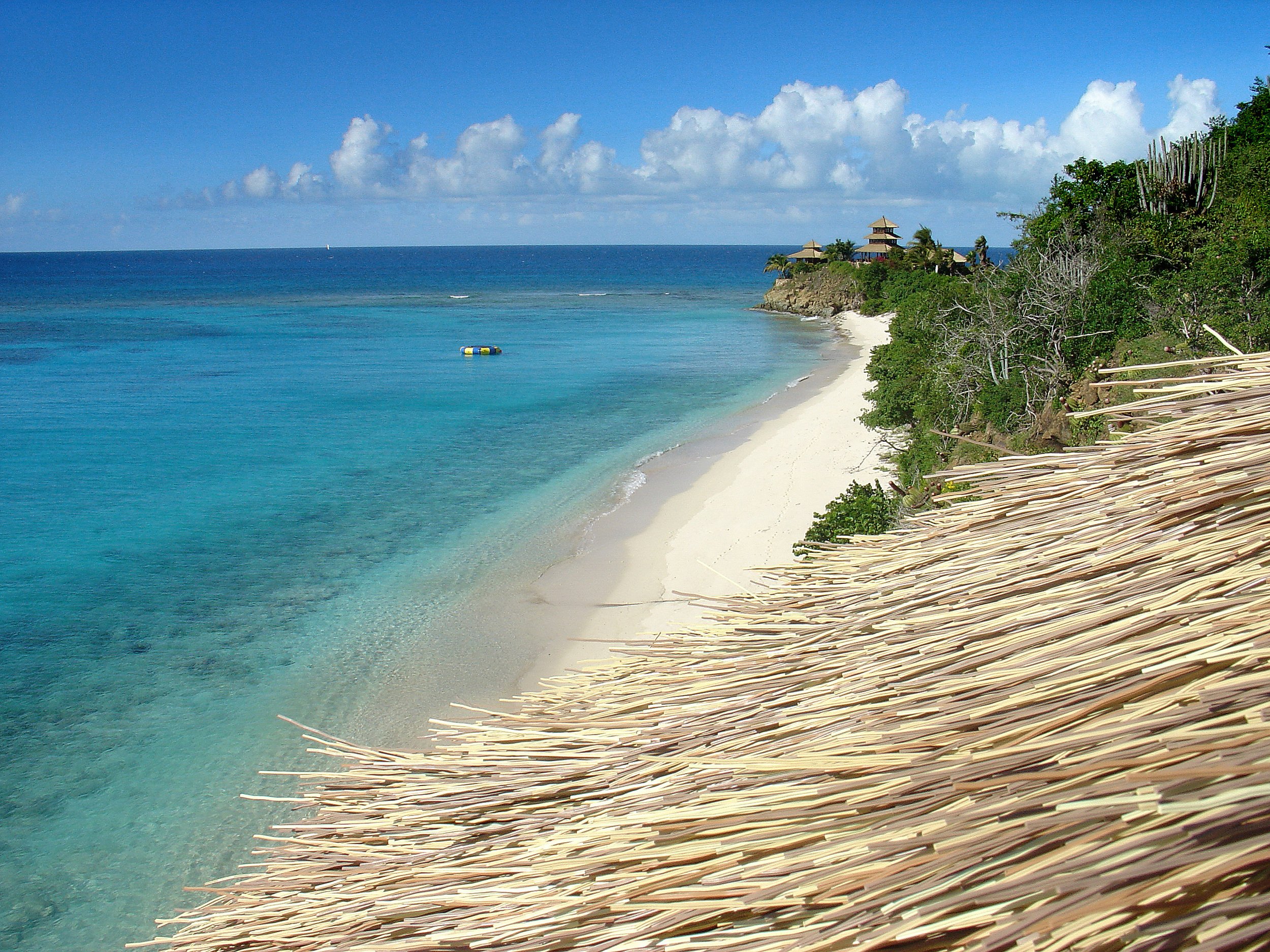Synthetic Thatch Roof Replacement
Here at Huber and Associates, we have been installing Endureed® synthetic thatch for more than 30 years, and are one of the nation’s few synthetic thatch roofing contractors. Our work can be seen on historic homes, private estates, and commercial properties all throughout the U.S., The Caribbean and overseas. We use synthetic products that provide the classic look of reeds or straw, but have the advantage of lasting longer and requiring less maintenance.
Over the years, we've completed many complex projects for a range of discerning clients. You can see our work at several prominent resorts and theme parks, including:
Necker Island Resort, British Virgin Islands (above)
Nashville Zoo, Nashville, Tennessee (below)
What Is Thatch Roofing?
Thatching is an old roofing technique that originated hundreds of years ago, and used locally sourced vegetation.
Around the world, there are various thatching methods that were passed down from generation to generation and varied per region. At its most basic, however, thatching involved making bunches of dried reed, straw, rushes, grass or some other type of vegetation; lining them up tightly on a pre-made framework on a roof; and then adding layer upon layer until the entire roof is covered.
It’s important that the roof has enough of a slant so that the vegetation can lead the water from any precipitation off the roof to protect the inner roof. And because the thatching materials are densely packed together, they trap air between them and function as insulation. This made thatch roofing a widespread roofing material in both temperate and tropical climates.
The materials used for thatching vary widely and were usually defined by local vegetation. In Europe, traditional materials include reed and the less popular straw. In Hawaii, lauhala and pili grass are used. Bali’s thatched roofs are usually made of alang-alang or ijuk, while sugar cane is a commonly used material in Kenya. In Dominica and Fiji, palm leaves are the most prevalent thatching materials.
More recently, high-quality synthetic thatch — artificial thatch — has started to become more popular in developed countries due to its longevity and durability.
A Concise History of Thatch Roofing
Thanks to the ready availability of local materials that can be used for thatching, thatch has been used for centuries all over the world on everything from Tiki huts in the South Pacific to whimsical cottages in the British Isles.
In general, historians believe that thatch has been used as a roofing material in many regions around the world for literally thousands of years. For example, In Europe, thatching was used as far back as prehistoric times and has survived until the present day.
It has also been commonly used throughout Central and South America for centuries. There is ample evidence that the Mayans, Incans and the Aztec used thatch as a roof covering for both homes and communal buildings. Thatch is also a traditional roofing material in many regions of Africa, as well as in Japan and Korea.
In the U.K., no evidence survives of thatch roofs from the Paleolithic period, although experts believe homes during that era generally had roofs made of bulrushes, cattail, heather and, later still, from straw. The first true evidence of thatch roofs in the British Isles dates back to the early Middle Ages, around 700 A.D. Later, in the 13th century, thatch was not only used for regular homes, but also for churches, grand homes, castles and colleges.
Nevertheless, due to the risk of fire, the use of thatch was forbidden in London after 1212. It’s interesting to note, however, that according to experts, there are still a couple of hundred roofs with thatch dating back to the early 14th century in the U.K. Because people added new layers, the old layers remained preserved — providing modern-day historians with more information about construction and agriculture in the 13th and 14th centuries.
In North America, thatch was used by Native Americans such as the Powhatan Indians long before colonial times. In addition, early European settlers brought their own thatching techniques to the New World. However, without their customary materials, they had to adapt their techniques to the local vegetation.
Today, thatch is still widely used around the world, especially by poor populations in developing countries. In contrast, in Europe and the U.S., thatched roofing is the choice of the more affluent, who like it for its aesthetics. Additionally, some homeowners purchase historic homes whose roofs are made of thatch.
Examples of Thatch Roofing
There are many examples of thatch roofing around the world. Here are some of the most famous:
The reconstructed Globe theater in London, the U.K.: While nobody knows exactly what the Globe theater looked like in Shakespeare’s day, historians, archeologists and architects worked hard to create a functional modern-day version. One thing is for certain, however: The original Globe’s roof was made from water reed thatch — and so is the new one. This magnificent building and tribute to the great playwright was opened by Queen Elizabeth in June 1997.
Anne Hathaway’s cottage, Stratford-upon-Avon: With its white door, sand-colored brick, leaded glass windows and high thatched roof that reaches down to the rose bushes and fox gloves in the garden, the cottage is the perfect example of an idyllic English countryside hideaway.
The Meru towers of the Besakih Temple in Bali: The spectacular Meru towers, each dedicated to a different deity, consist of multiple tiers. Each tier is covered in thatch made out of black ijuk fibers, lending it a striking appearance.
The historic villages of Ogomachi in Japan’s Gokayama region and the villages of Suganuma and Ainokura in the Shirakawa-go: These three villages, which are designated as a World Heritage Site, are situated in a region that is notoriously difficult to access. As a result, they remained isolated for many centuries. During this time, a unique housing style evolved called “Gassho” houses: Homes with steeply-pitched roofs covered in thatch made from the local vegetation.
Why Synthetic Thatch Roofing?
Thatch has been used for centuries all over the world on everything from Tiki huts in the South Pacific to whimsical cottages in the British Isles. Thatch roofs were originally crafted from vegetation such as straw, reeds, rushes, grasses and palm fronds. Because of this, they are highly distinctive and many people prize them for their natural, organic look.
Depending on the type of thatch used, the finished product can be a foot thick, which adds to its soft and inviting appearance. Because it relies on a buildup of grasses or reeds for shedding water, thatching should be installed on a steeper roof slope than conventional materials. This adds to its highly unique aesthetic properties.
Thatch roofing isn't for everyone, but those who prize its natural look and feel will find much to admire in the fine craftsmanship of a Huber & Associates build. We specialize in bringing to life the creative vision of our clients, utilizing quality materials and exceptional artistry to create designs that offer long-lasting quality and good looks you'll appreciate for years to come.
About Synthetic Thatch
Today's products are highly durable, attractive and virtually indistinguishable from natural materials. Huber and Associates is proud to install Endureed® Synthetic Thatch. Its Class A Fire Rating and durability greatly exceed that of natural thatch without compromising the beautiful, exotic appearance. When it is correctly installed by our team of experts, a synthetic thatch roof can provide:
A lifespan of 50 years or more, compared to the 15 to 20-year lifespan of natural thatch
Virtually maintenance-free performance, saving you time and money
Superior resistance to mold, rot and decay, which are common issues with natural thatch products
Improved safety in the event of heavy winds, fire or other natural disasters
A range of color options that don’t fade with exposure to the sun
A natural deterrent to bugs, birds and other pests, which can be a problem with natural thatch
All-weather performance in virtually any climate
To learn more about the benefits of synthetic thatch, contact Huber & Associates. Of course, if you prefer a natural product, we would be happy to source several options for you.
Our Services
Huber & Associates has extensive experience repairing, restoring and replacing synthetic thatch roofs. We have worked in high-end private residences as well as hotels, villas and other commercial properties. Our services include:
Thatch re-roofing: Whether you want to replace natural thatch with a synthetic product or change up the look of your property by replacing an existing tile or asphalt roof, we can help. Our team offers turnkey support for any project, from design and material sourcing to installation and ongoing maintenance.
Thatch roof restoration: When repairs are not enough, but you want to preserve the look of a natural thatch roof with synthetic, Huber & Associates can provide more comprehensive restoration services. We specialize in historic restorations — our team is trained to do the research and meticulous work necessary to maintain fidelity to the original design of your property.
Replacing thatch roof with synthetic thatch: If you want to replace your natural thatch roof with synthetic thatch, you need a synthetic thatch roofing contractor who understands how to provide you with all the benefits of a synthetic product — without losing the charm of the natural materials. Our team of specialized thatch experts are happy to advise you on your best options for a synthetic thatch roof installation.
Every job begins with a thorough consultation in which we go over your goals and recommend the best combination of services and products. We will also provide a detailed estimate outlining all costs involved in a job, as well as a timeline for completion.
Historical Restoration And Preservation Experts
If you're looking for a synthetic thatch roof, Huber & Associates can help. We have installed thatch roofs for clients all around the world. Though we routinely work on new constructions, our specialty is historical restorations and repairs. Let us bring an older property into the 21st century by replacing a natural thatch roof with a synthetic alternative or by repairing areas that have become damaged by time.
Give us a call today - 800-327-8115 - or submit the form below to learn more about thatch roofing restoration opportunities. Huber & Associates provides historical restoration and preservation to roofs all over the world.













